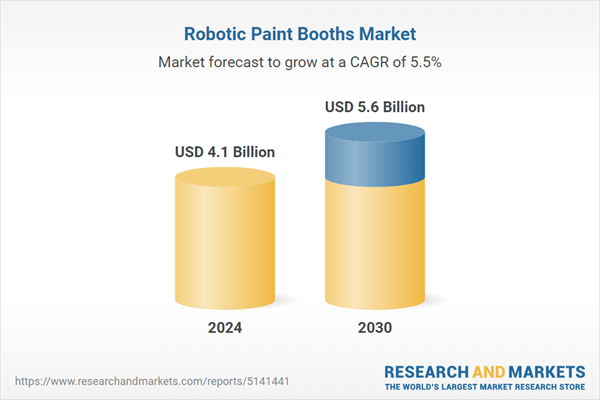The global market for Robotic Paint Booths was valued at US$4.1 Billion in 2024 and is projected to reach US$5.6 Billion by 2030, growing at a CAGR of 5.5% from 2024 to 2030. This comprehensive report provides an in-depth analysis of market trends, drivers, and forecasts, helping you make informed business decisions. The report includes the most recent global tariff developments and how they impact the Robotic Paint Booths market.
Segments: Product (Paint Booths, Paint Robots); End-Use (Automotive, Non-Automotive).
Geographic Regions/Countries: World; United States; Canada; Japan; China; Europe (France; Germany; Italy; United Kingdom; Spain; Russia; and Rest of Europe); Asia-Pacific (Australia; India; South Korea; and Rest of Asia-Pacific); Latin America (Argentina; Brazil; Mexico; and Rest of Latin America); Middle East (Iran; Israel; Saudi Arabia; United Arab Emirates; and Rest of Middle East); and Africa.
The analysts continuously track trade developments worldwide, drawing insights from leading global economists and over 200 industry and policy institutions, including think tanks, trade organizations, and national economic advisory bodies. This intelligence is integrated into forecasting models to provide timely, data-driven analysis of emerging risks and opportunities.
Global Robotic Paint Booths Market - Key Trends and Drivers Summarized
What Are Robotic Paint Booths and How Do They Benefit the Automotive Industry?
Robotic Paint Booths are advanced automated systems used in automotive manufacturing to apply paint and coatings to vehicles with high precision, consistency, and efficiency. These systems are equipped with robotic arms that are programmed to perform complex painting tasks, such as spraying, dipping, and curing, in a controlled environment. Robotic paint booths ensure uniform paint application, reduce overspray, and minimize paint wastage, leading to significant cost savings and improved quality. In addition to the automotive sector, these booths are also used in industries such as aerospace, heavy machinery, and furniture manufacturing. The adoption of robotic paint booths is becoming increasingly essential as manufacturers strive to enhance production efficiency, reduce environmental impact, and meet stringent quality standards.How Are Technological Advancements Transforming the Market for Robotic Paint Booths?
Technological advancements are driving significant innovations in robotic paint booths, making them more efficient, versatile, and environmentally friendly. The integration of AI and machine learning is enabling real-time optimization of painting processes, including adaptive spray patterns, speed adjustments, and paint flow control, resulting in better surface coverage and reduced material usage. The development of multi-axis robotic arms with advanced sensors and control systems is enhancing the precision and flexibility of paint application, allowing for complex geometries and surfaces to be coated evenly. Innovations in eco-friendly paint materials and low-VOC (volatile organic compound) coatings are further aligning robotic paint booths with environmental regulations and sustainability goals. Additionally, the use of IoT-enabled sensors and cloud-based monitoring systems is enabling predictive maintenance and remote diagnostics, reducing downtime and improving overall operational efficiency.What Challenges and Opportunities Exist in the Robotic Paint Booths Market?
The robotic paint booths market faces several challenges, including high capital investment, complex installation and integration processes, and the need for regular maintenance. The initial costs associated with purchasing and setting up robotic paint booths, along with the required software, training, and support, can be substantial, which may deter some manufacturers, especially smaller players. Ensuring compatibility with existing production lines and integrating with other automation systems can also be technically demanding. However, these challenges present significant opportunities for growth and innovation. The increasing demand for high-quality, durable paint finishes in the automotive and aerospace sectors is driving the adoption of advanced robotic paint booths. The expansion of electric vehicle (EV) manufacturing, which requires specialized coatings for battery packs and lightweight materials, is further boosting the market potential. Moreover, the growing emphasis on sustainability, reducing VOC emissions, and minimizing waste is creating new opportunities for eco-friendly and energy-efficient robotic paint booth solutions.What Factors Are Driving the Growth of the Robotic Paint Booths Market?
The growth in the Robotic Paint Booths market is driven by several factors, including the rising demand for high-quality and efficient painting solutions in automotive and industrial manufacturing. Technological advancements in AI, machine learning, multi-axis robotics, and eco-friendly coatings are enhancing the precision, flexibility, and environmental compliance of robotic paint booths, driving their adoption. The increasing focus on reducing production costs, minimizing waste, and improving workplace safety is also contributing to market growth. Additionally, the expansion of the electric vehicle (EV) market, which requires specialized coatings and finishes, is boosting the demand for robotic paint booths. The emphasis on sustainable manufacturing practices and the need for regulatory compliance in reducing VOC emissions are further propelling the robotic paint booths market forward.Report Scope
The report analyzes the Robotic Paint Booths market, presented in terms of units. The analysis covers the key segments and geographic regions outlined below.Segments: Product (Paint Booths, Paint Robots); End-Use (Automotive, Non-Automotive).
Geographic Regions/Countries: World; United States; Canada; Japan; China; Europe (France; Germany; Italy; United Kingdom; Spain; Russia; and Rest of Europe); Asia-Pacific (Australia; India; South Korea; and Rest of Asia-Pacific); Latin America (Argentina; Brazil; Mexico; and Rest of Latin America); Middle East (Iran; Israel; Saudi Arabia; United Arab Emirates; and Rest of Middle East); and Africa.
Key Insights:
- Market Growth: Understand the significant growth trajectory of the Paint Booths segment, which is expected to reach US$2.9 Billion by 2030 with a CAGR of a 5.3%. The Paint Robots segment is also set to grow at 5.7% CAGR over the analysis period.
- Regional Analysis: Gain insights into the U.S. market, valued at $1.1 Billion in 2024, and China, forecasted to grow at an impressive 8.6% CAGR to reach $1.2 Billion by 2030. Discover growth trends in other key regions, including Japan, Canada, Germany, and the Asia-Pacific.
Why You Should Buy This Report:
- Detailed Market Analysis: Access a thorough analysis of the Global Robotic Paint Booths Market, covering all major geographic regions and market segments.
- Competitive Insights: Get an overview of the competitive landscape, including the market presence of major players across different geographies.
- Future Trends and Drivers: Understand the key trends and drivers shaping the future of the Global Robotic Paint Booths Market.
- Actionable Insights: Benefit from actionable insights that can help you identify new revenue opportunities and make strategic business decisions.
Key Questions Answered:
- How is the Global Robotic Paint Booths Market expected to evolve by 2030?
- What are the main drivers and restraints affecting the market?
- Which market segments will grow the most over the forecast period?
- How will market shares for different regions and segments change by 2030?
- Who are the leading players in the market, and what are their prospects?
Report Features:
- Comprehensive Market Data: Independent analysis of annual sales and market forecasts in US$ Million from 2024 to 2030.
- In-Depth Regional Analysis: Detailed insights into key markets, including the U.S., China, Japan, Canada, Europe, Asia-Pacific, Latin America, Middle East, and Africa.
- Company Profiles: Coverage of players such as Beijing Smartmi Technology Co.,Ltd., Beringer GmbH, CLEANTEK, Compact and Bale Ltd., Compaction and Recycling Equipment, Inc. and more.
- Complimentary Updates: Receive free report updates for one year to keep you informed of the latest market developments.
Some of the 42 companies featured in this Robotic Paint Booths market report include:
- Beijing Smartmi Technology Co.,Ltd.
- Beringer GmbH
- CLEANTEK
- Compact and Bale Ltd.
- Compaction and Recycling Equipment, Inc.
- Compactors, Inc.
- Danrobotics A/S
- Dulux
- G.G. Compactors Ltd.
- Global Finishing Solutions
Tariff Impact Analysis: Key Insights for 2025
Global tariff negotiations across 180+ countries are reshaping supply chains, costs, and competitiveness. This report reflects the latest developments as of April 2025 and incorporates forward-looking insights into the market outlook.The analysts continuously track trade developments worldwide, drawing insights from leading global economists and over 200 industry and policy institutions, including think tanks, trade organizations, and national economic advisory bodies. This intelligence is integrated into forecasting models to provide timely, data-driven analysis of emerging risks and opportunities.
What’s Included in This Edition:
- Tariff-adjusted market forecasts by region and segment
- Analysis of cost and supply chain implications by sourcing and trade exposure
- Strategic insights into geographic shifts
Buyers receive a free July 2025 update with:
- Finalized tariff impacts and new trade agreement effects
- Updated projections reflecting global sourcing and cost shifts
- Expanded country-specific coverage across the industry
Table of Contents
I. METHODOLOGYII. EXECUTIVE SUMMARY2. FOCUS ON SELECT PLAYERSIII. MARKET ANALYSISSOUTH KOREAREST OF ASIA-PACIFICARGENTINABRAZILMEXICOREST OF LATIN AMERICAIRANISRAELSAUDI ARABIAUNITED ARAB EMIRATESREST OF MIDDLE EASTIV. COMPETITION
1. MARKET OVERVIEW
3. MARKET TRENDS & DRIVERS
4. GLOBAL MARKET PERSPECTIVE
UNITED STATES
CANADA
JAPAN
CHINA
EUROPE
FRANCE
GERMANY
ITALY
UNITED KINGDOM
SPAIN
RUSSIA
REST OF EUROPE
ASIA-PACIFIC
AUSTRALIA
INDIA
LATIN AMERICA
MIDDLE EAST
AFRICA
Companies Mentioned (Partial List)
A selection of companies mentioned in this report includes, but is not limited to:
- Beijing Smartmi Technology Co.,Ltd.
- Beringer GmbH
- CLEANTEK
- Compact and Bale Ltd.
- Compaction and Recycling Equipment, Inc.
- Compactors, Inc.
- Danrobotics A/S
- Dulux
- G.G. Compactors Ltd.
- Global Finishing Solutions
Table Information
| Report Attribute | Details |
|---|---|
| No. of Pages | 294 |
| Published | April 2025 |
| Forecast Period | 2024 - 2030 |
| Estimated Market Value ( USD | $ 4.1 Billion |
| Forecasted Market Value ( USD | $ 5.6 Billion |
| Compound Annual Growth Rate | 5.5% |
| Regions Covered | Global |









